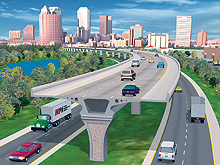
honolulutraffic.com
Offering cost-effective ways to reduce traffic congestion in Honolulu
![]() November 27, 2009.
November 27, 2009.
Gov. Cayetano blitzes Hannemann's handling of rail:
Former Governor Ben Cayetano has an op/ed in today's Advertiser. He details how Hannemann's mishandling of the environmental issues may well be his undoing.
He also makes the point that the rail system still faces many hurdles and that the Environmental Impact Statement and other environmental issues critical to the project shouldn't be rushed.
A very good op/ed from someone who is not known for pulling his punches.
![]() November 24, 2009.
November 24, 2009.
Lingle promises thorough review of rail project:
Today's Advertiser covers the Governor's latest pronouncements on the rail project. Here's the first few paragraphs and after that a link to the story and to the Governor's actual four minutes of comments from the Mike Buck Show podcast:
"Gov. Linda Lingle said yesterday that she would not "rubber stamp" the final environmental impact statement on Honolulu's $5.5 billion rail project, promising a thorough review of whether the city adequately explored alternatives and whether the financial plan remains sound given the recession."
"Both the state and the federal government have to accept the final environmental report, a key benchmark before the city can begin construction on the project."
"Honolulu Mayor Mufi Hannemann, who wants to break ground early next year, has said the Lingle administration has already looked at the draft report and that the governor merely "closes the loop" by formally accepting the finished document."
"Lingle, on her weekly appearance on the Mike Buck radio show on KHVH, said she would take her time. "I'm going to spend my life in Hawai'i," Lingle said. "I'm not going to have people look back and say 'Why couldn't you see that this couldn't work? Why didn't you force them to review the alternatives?'"
Advertiser story Mike Buck Show podcast, 20:00 mins. to 23.50 mins.
![]() November 23, 2009.
November 23, 2009.
"Honolulu officials faulted for rejecting ground-level trains"
Today's Honolulu Advertiser carries a story by reporter Sean Hao on the City's inadequate study of at-grade light rail.
"The most recent study of an at-grade Honolulu rail system was conducted this spring by New Jersey transportation consultant Phil Craig for the Kamehameha Schools. Honolulu could save an estimated $1.7 billion by building about half of its planned elevated commuter train system at ground level, according to the study."
"Craig proposed building the train system at ground level from East Kapolei to Waipahu and from Middle Street to Ala Moana Center. Only the segment from Waipahu to Middle Street, or about 10 out of a total 20 miles, would be built on an elevated guideway."
This is a well-told story covering both sides of the issue, which will, of course, annoy the city since it only wants one side of the story told.
![]() November 20, 2009.
November 20, 2009.
Oberstar plans a costly new exercise in lifestyle modification
Heritage Foundation's Ron Utt today describes the new Transportation Bill being introduced by Rep. James Oberstar (D-MN) as follows:
"Oberstar's [bill] would mark a dramatic, harmful change in federal transportation policy by:
• Shifting resources from cars to trolleys and buses,
• Requiring a huge tax increase to fund these new commitments,
• Centralizing transportation decisions in Washington,
• Necessitating a substantial increase in the number of state, local, and federal government employees, and
• Discouraging the private sector from investing in surface transportation projects."
Higher Taxes for Social Engineering
"As written, many provisions of STAA have two primary purposes:
• Deterring the use of automobiles; and
• Forcing residential and commercial development into higher density urban communities where public transit, walking, and bicycling would be the main form of transportation."
"To do this, Oberstar's bill would encourage and require states and metropolitan planning organizations to use new land use regulations that would lead to much higher densities than Americans now prefer."
"To fund these new commitments and lifestyle changes, STAA would require an additional $150-$200 billion in taxes over the next six years. Such an increase would be equivalent to a 112 percent increase in the federal fuel tax and an unspecified increase in other federal taxes to fund the added $50 billion higher-speed rail scheme STAA would also create."
"One of the principal reasons given for the need to enact these bills relates to greenhouse gases and the environment. But evidence on fuel efficiency and greenhouse gas emissions as they relate to different modes of travel and land use patterns reveal that the provisions of STAA would yield little or no benefit to the nation or to the environment.[2] Instead, both would impose great costs and inconveniences on American citizens and business. For this reason, both bills should be withdrawn from consideration or substantially modified in way that they would benefit the nation, not harm it."
OUR OPINION: These Smart Growth people have no sense of our nation's history when they blame the suburban lifestyle on the automobile. The suburbs began with the introduction of the horsecar in the early to mid-1800s and burgeoned with the cheaper and faster electric streetcar. By the time that the automobile became any kind of factor in the mid-1920s, suburbs were already in place. Autos only continued the trend. An excellent and very readable book on the subject is Professor Sam Bass Warner's Streetcar Suburbs,about how Boston grew from 1870 on.
Our dense urban populations of the 1800s and early 1900s could not wait to get out of the kind of dense urban living that the Oberstars of the world want to impose on us. This crowd also includes a significant number of legislators in our own Hawaii Legislature.
Read Ron Utt's article in its entirety.
![]() November 18, 2009.
November 18, 2009.
Honolulu Weekly: "Railroaded"
Today's Honolulu Weekly has as its lead story, Railroaded: Inside the raging debate over heavy rail. The first two paragraphs are:
"Honolulu Rail — Imagine an elevated concrete train viaduct rising from abandoned sugarcane fields just east of Kapolei and barreling through Waipahu, Pearl City and ‘Aiea, past Pearl 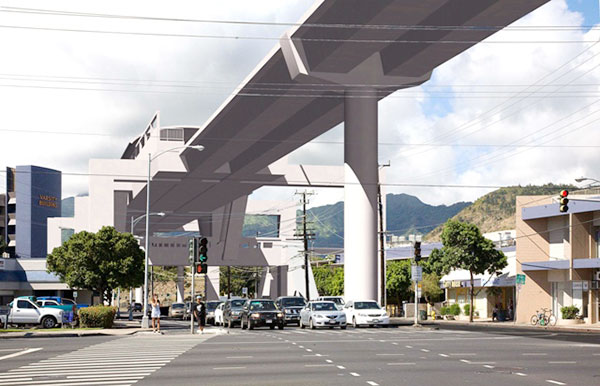 Harbor and the airport and into downtown. It shadows the length of Dillingham Boulevard. Nimitz Highway’s curve around the downtown harbor front is capped by concrete.
Harbor and the airport and into downtown. It shadows the length of Dillingham Boulevard. Nimitz Highway’s curve around the downtown harbor front is capped by concrete.
"Imagine 21, three-story, football-field-sized platform stations, with their escalators, elevators, stairs and other nooks and crannies. Think about how every future extension of the system will demand the same costly elevated tracks. Imagine the costs when–and if–the critical extensions to UH Manoa and Waikiki are built. Figure out, if you can, how these two separate east-bound viaducts will thread their way out of Ala Moana Center and around the Hawaii Convention Center."
Read the story; it will have your imagination running wild.
![]() November 17, 2009.
November 17, 2009.
Dr. Prevedouros describes our traffic congestion problem:
Dr. Prevedouros, Professor of Traffic Engineering at UH, yesterday in the Hawaii Reporter asked and answered the question, Is There a Plan to Solve Traffic Congestion of Oahu?
He tells us that, "Unlike most other urban areas, where congestion decreased slightly from two years ago, the latest Urban Mobility Report from the Texas Transportation Institute shows that congestion has gotten worse in Honolulu."
"Of course it is not new to residents that Honolulu is a congested city. Honolulu is one of the nation’s most lane deficient cities. It has a traffic congestion problem; not a transit ridership problem. A traffic problem cannot be solved with transit solutions."
"Some say that Honolulu has such severe congestion because its car ownership is very high. Some politicians even claim that Honolulu is number one in car ownership. This is totally wrong. Honolulu’s car ownership ranks 64th in the nation, much lower than its rank in population!"
"So are we going to see an improvement in congestion? The rail proposal clearly says that: (1) TheBus carries 6% of the trips on Oahu now, and (2) TheBus and TheRail together will carry 7% of the trips 20 years from now. What’s the end result? Much worse traffic congestion."
Read the whole op/ed where he interviews two of the nation's leading urban transportation experts and also answers his own question. Of course there is no plan to work on traffic congestion; we only have rail plans.
![]() November 14, 2009.
November 14, 2009.
Book Review: "Transit Maps of the World":
For anyone at all interested in urban rail transportation, Transit Maps of the World by Mark Ovenden is an absolute bargain (Penguin Books, 2007, 144 pages, 11” x 9”, $16.50 from Amazon.com). This large book is beautifully illustrated with route maps of every single one of the world’s urban rail transit lines and described as, “An object lesson in information design.”
While one would think that only nerds would buy it, the BBC said of it, “The sort of book you couldn’t imagine you needed until you got it, and now you can’t imagine how you could do without it. It’s fantastic!” The Guardian of London called it, “Delightful. Oddball.”
Get it. You can always relegate it to the bathroom.
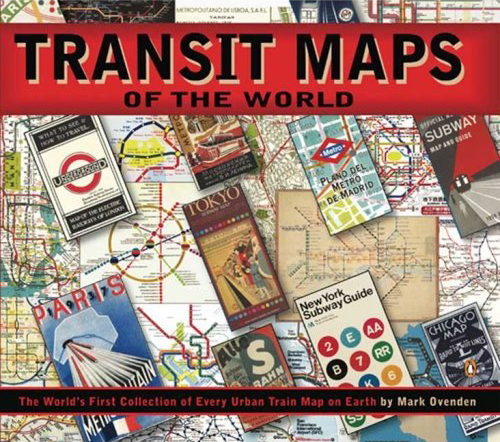
![]() November 13, 2009.
November 13, 2009.
There is a difference between Honolulu and London:
We keep hearing from rail supporters how wonderful the rail lines are London, New York, Paris, Tokyo — the list goes on. The difference between us and these old dense cities is that they are networks of subways, which is why they work well.
The map below is the section of London that most tourists spend their time in. It is five miles in width and within this area there are 44 subway stations and 13 railway stations — 47 stations all interconnected.
Instead of a network, Honolulu's is to be a single line with one station each mile with 5 to 6 of its 21 stations in an area of this same size. In other words you will hardly get anywhere on our rail line without also using a bus.
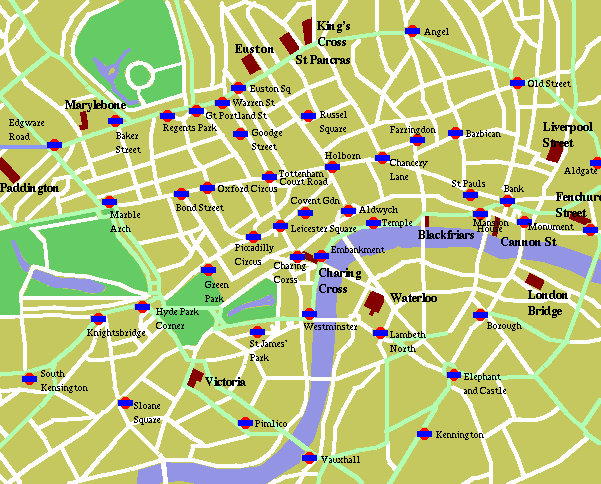
![]() November 10, 2009.
November 10, 2009.
Rail tax collections way below latest city projections:
In forecasts that the City made only in August they forecast that the rail tax collections for the fiscal year ending next June 30 would be level with the previous year. However, the state's GE tax collections for the first four months are down 12.9 percent and it therefore highly unlikely that the City will get anywhere near their forecast.
In today's Advertiser, the Governor's Senior Policy Adviser, Linda Smith noted that these tax decreases were after the Legislature had significantly increased taxes.
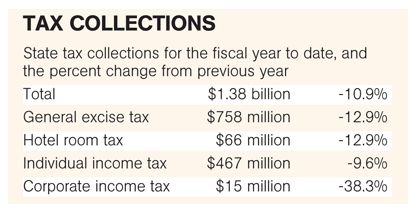
![]() November 9, 2009.
November 9, 2009.
We’re plodding steadily down the road to ruin:
The New York Times tells us in a story last week that Denver’s light rail originally billed as $4.7 billion has now grown. “Projected costs have ballooned to nearly $7 billion, and the system faces a budget gap of $2.2 billion, mainly because of a sharp drop in sales tax revenues.”
Does that sound familiar? They go on:
“Many more systems, though, are comrades in misery with Denver.
“In New York, for example, home to the nation’s largest transit system, tax increases for a $1.9 billion state bailout of the bus and train system took effect in September, including a payroll tax and a surcharge on taxi rides. In Miami, rail administrators hope a special session of the State Legislature could rescue the system with new revenue.
“Other places are taking Denver’s tack, trying to reposition the appeal of transit from getting around to getting a job, arguing that new rail lines will provide economic stimulus now, and transportation and environmental benefits later on.
“In Los Angeles, for example, where voters approved a $13 billion sales tax increase in 2008 to pay for 12 new transit projects, city officials announced a plan last month to sharply accelerate the schedule for job creation.”
We keep writing about the risks and uncertainties about these large rail projects but our citizens still keep plodding steadily on down the road to ruin.
Correction to the approvals needed for Section 4(f):
In the November 1 post below, we said that Section 4(f) needed the approval of the Federal Transit Administration, the Advisory Council on Historic Preservation, the State Historic Preservation Officer, and the National Park Service. We were wrong. It only needs the approval of FTA; the others are only to be consulted.
![]() November 1, 2009.
November 1, 2009.
Why there is a great deal of confusion about rail right now:
There are three different environmental processes playing out at the moment and causing a great deal of confusion.
First, the Section 106 process, dealing with the protection of historic properties. (36CFR800)
Second, the Section 4(f) process dealing with preserving “the natural beauty of the countryside and public park and recreation lands ... and historic sites.” (23CFR774)
Third, is the Environmental Impact Statement itself.
While it looks as though the 4(f) process will be incorporated in the EIS and the Section 106 process will be in the form of a Programmatic Agreement and be recognized in the EIS, they are still three different processes with different approvals required for each.
Section 106 needs the approval of the Federal Transit Administration, the Advisory Council on Historic Preservation, the State Historic Preservation Officer, and the National Park Service.
Section 4(f) needs the approval of the same entities but operating in different capacities since the governing statutes and regulations are different.
The EIS needs the approval of the Governor and the FTA.
We surmise (since no one knows how events will play out) that over time some consensus will be reached on the Section 106 Programmatic Agreement.
Section 4(f) is a different matter because apparently that process has not even been started. We suspect that this is what is giving the City headaches since it requires the City to prove that "there is no feasible and prudent avoidance alternative”. In short, that there is no other transportation alternative that avoids the rail project’s effect on historic properties.
"Alternatives Analysis: The intent of the Section 4(f) statute and the policy of the USDOT is to avoid the use of significant public parks, recreation areas … and historic sites as part of a project, unless there is no feasible and prudent alternative to the use of such land.” (FHWA Section 4(f) Policy, p. 4)
If there is an alternative that is “feasible and prudent” and avoids the affected properties then that is the alternative that must be used.
May we mention our greatly maligned but “feasible and prudent” Managed Lanes Alternative? It avoids Honolulu’s historic properties, including likely major sites of iwi kupuna. UH Professor Prevedouros has demonstrated, and many other experts believe, that the MLA will show greater benefits than rail transit at a far lower cost.